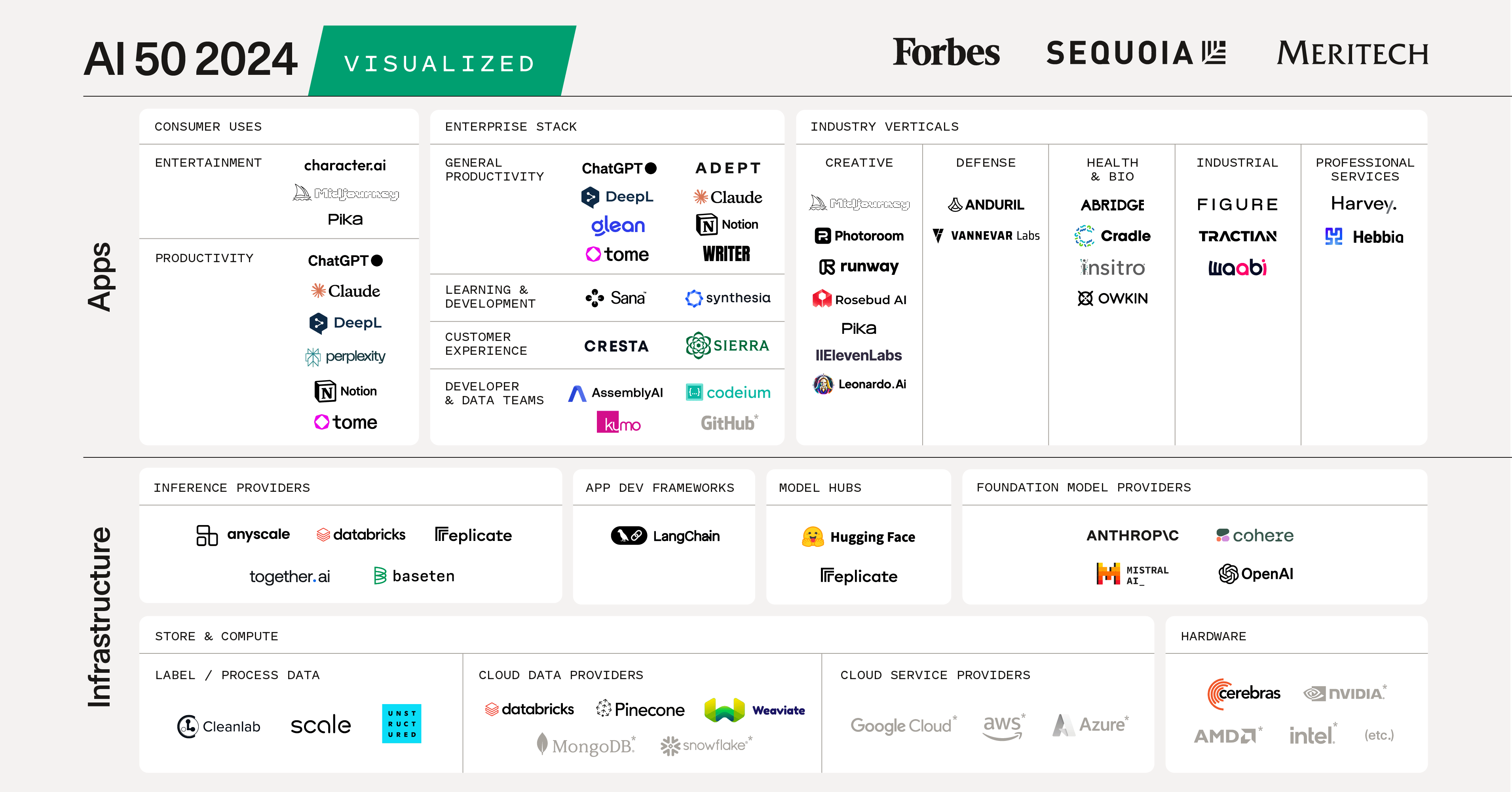AI 50: Companies of the Future

🌈 Abstract
The article discusses the 2024 edition of the AI 50 list, which highlights how generative AI is starting to transform enterprise productivity. It covers the following key points:
- Generative AI has moved to the forefront of the AI 50 list, with application companies continuing to dominate.
- Many companies are integrating AI into their processes to accelerate KPIs and achieve productivity gains.
- The category of enterprise general productivity has doubled, with companies broadening their offerings to meet growing customer demands.
- The lines are blurring between consumer and prosumer for creative software, with more productivity apps catering to different customer levels.
- A new industrial sector has emerged, showing how the integration of AI software with hardware will transform physical work.
- AI is positioned to change the cost structure and increase productivity in crucial areas like education and healthcare.
🙋 Q&A
[01] AI 50: Companies of the Future
1. What is the main focus of the 2024 edition of the AI 50 list?
- The 2024 edition of the AI 50 list shows how generative AI is starting to transform enterprise productivity.
2. How has the role of generative AI changed in the AI 50 list?
- Last year, generative AI moved from the background to the forefront of the AI 50 list, and this year it is front and center as we see the beginnings of major AI productivity gains.
3. What are some examples of how companies are integrating AI to achieve productivity gains?
- ServiceNow is achieving case avoidance rates of nearly 20% with their AI-powered Now Assist.
- Palo Alto Networks has reduced the cost of processing expenses with AI.
- Hubspot has scaled customer support with AI.
- Klarna has achieved over $40 million in run-rate savings by building AI into their customer support.
4. What is expected to happen in the future with regards to user experience and user interface?
- Tomorrow, we expect to see UX and UI reimagined around the capabilities of AI, with replicating existing functions better and cheaper, followed by evolving entirely new user interfaces to deliver valuable new experiences.
[02] What's New This Year?
1. What is the key highlight in the changes to the AI 50 list this year?
- The big movements in this year's AI 50 list highlight how generative AI is increasing enterprise and industry productivity.
2. How has the category of enterprise general productivity changed?
- The category of enterprise general productivity doubled this year, going from four companies to eight as they broadened their offerings to meet customers' growing demands.
3. What is happening with the lines between consumer and prosumer for creative software?
- The lines are blurring between consumer and prosumer for creative software, with companies like Photoroom, Pika, and Rosebud catering to both consumer and prosumer levels.
4. What new industrial sector has emerged in the AI 50 list?
- A new industrial sector has emerged, with companies like Figure in robotics, Tractian in industrial maintenance, and Waabi in self-driving, showing how the integration of AI software with hardware will transform physical work.
[03] Companies of the Future
1. How is AI expected to change the way companies operate in the future?
- As more AIs are developed, they will begin to work together as networks of AIs, driving demand for new infrastructure to support ever more powerful computation and crosstalk.
- Company building itself could become the work of AI agents, and someday entire companies might work like neural networks.
2. What are the potential changes in the characteristics of future companies?
- Future companies will be smaller, but the ease of company generation means there will be far more of them.
- Company formation will become faster and more fluid, with new ownership and management structures.
- Some large companies may be operated by a single AI engineer.
3. What are the critical questions that founders will need to answer to win the hearts and minds of the businesses of the future?
- What kinds of products will these companies make?
- What kinds of infrastructure and applications will they need?
- How will the workforce change?
- How will patterns of distribution and value capture change?
- What share of their total addressable market will be composed of people vs autonomous AI agents?
[04] What's Next
1. How can AI help drive down costs and increase accessibility in crucial areas?
- AI has the potential to reduce costs in crucial areas like healthcare and education, making them more accessible and affordable.
- These changes need to be made responsibly to mitigate job loss and drive job creation.
2. How can AI help improve society?
- AI can free up more people to tackle more problems and create a better society by abstracting away mundane work and allowing us to focus on more important issues and better tools for the future.